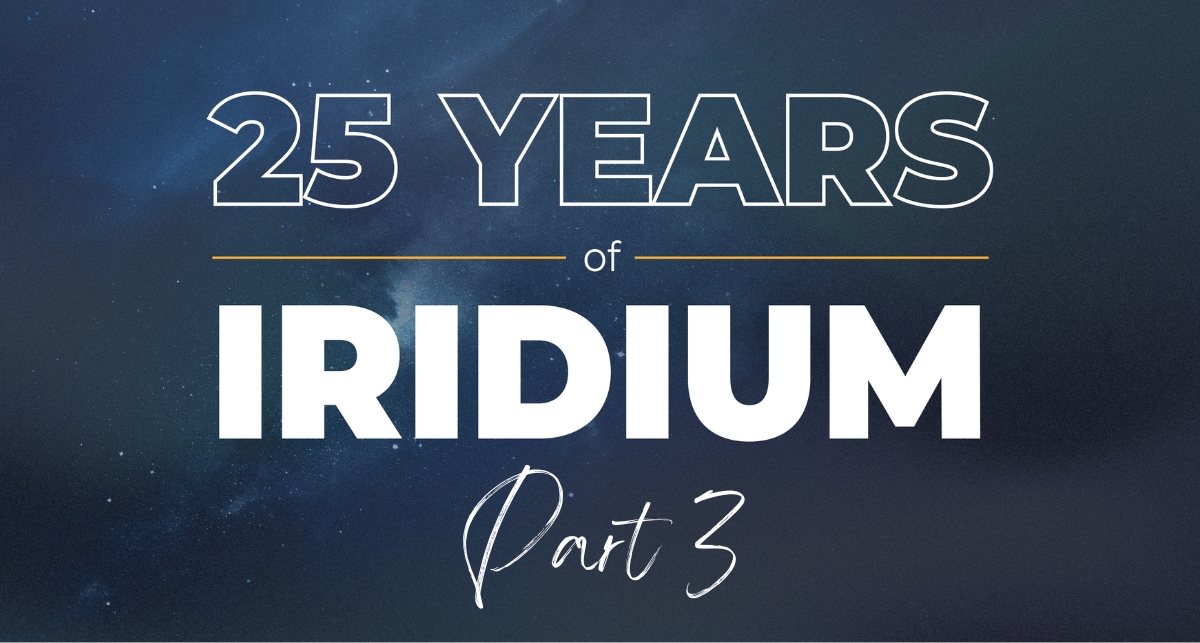Iridium Eras, Part 3: A Phoenix Rising from the Ashes

To celebrate Iridium’s 25th anniversary, we’re reflecting on the eras that made the company what it is today. From its iconic inception to infamous bankruptcy to its rise from the ashes, learn more about the world’s first and only truly global satellite network.
Transformation
In September 2006, Iridium was about to enter its transformation era. Matt Desch had just been named CEO and was presented quite the challenge: to launch a second-generation satellite constellation, usher in a new phase of fast growth and (hopefully) enjoy a CapEx holiday.
TL;DR
Iridium did it all. But for those of you who want the full story, please enjoy the rest of this chapter and stay tuned for chapter four.
Going Public
With no time to spare, in February 2007 Iridium announced its plans for the Iridium® NEXT program—a $3 billion network replacement program which many viewed as incredibly risky. In 2009, Desch led Iridium through a SPAC transaction to become a public company, renaming the company Iridium Communications Inc., and shortly thereafter, in 2010, announced partnerships with Thales Alenia Space and SpaceX—to build the Iridium NEXT satellites and to launch the constellation, respectively.
Winning
Between the years 2011 and 2017, there were times when it felt like momentum was coming to a screeching halt. However, that notion couldn’t have been less true. Despite many challenges and unpredictable road blocks (can you say launch delay?), there were many wins. It would be impossible to list them all, but the following achievements should help to provide context.
In 2011 alone, Iridium won the ‘North American Telecom Deal of the Year for 2010’ for its $1.8 billion Coface deal to finance the Iridium NEXT program; the Federal Aviation Administration (FAA) approved Iridium for the Future Air Navigation System (FANS); the company reached 500,000 subscribers, and the Iridium Extreme® became the first satellite phone to offer SOS service.
In 2012, Iridium and NAV CANADA announced a joint venture, Aireon, to revolutionize global air traffic surveillance. It was then announced that each Iridium NEXT satellite would carry Aireon’s technology as a hosted payload, showcasing how much was riding on the program’s success (figuratively and literally).
Soon after in 2013, Iridium announced a first-of-its-kind five-year, fixed price, unlimited airtime contract with the Department of Defense (DoD) Defense Information Systems Agency (DISA); and in 2014 Iridium launched Iridium GO!®, its global satellite hotspot device. In 2015, Iridium launched Iridium Push-to-Talk (PTT), and also announced Iridium Certus® — its next-generation L-band satellite broadband platform that would operate over the refreshed constellation.
So, yeah, a lot was accomplished.
Up Next: NEXT
Then finally, in 2017, the Iridium NEXT program gained momentum again. On January 14, 2017, SpaceX successfully launched the first batch of 10 Iridium NEXT satellites to Low Earth Orbit (LEO) onboard its Falcon 9 rocket. Over the next two years, every Iridium NEXT launch went off without a hitch, delivering 75 satellites to space without service interruption. Each successful launch marked a major company and industry milestone, bringing Iridium one step closer to achieving what many thought was impossible. On February 5, 2019, the final two Iridium NEXT satellites were successfully activated into the operational constellation, completing the largest technology refresh the space and satellite industries had ever seen.
While the eighth launch marked the end of Iridium’s network transformation era, it signified the start of a new era filled with rapid growth, relief (phew!) and the CapEx holiday of Matt Desch’s dreams.

